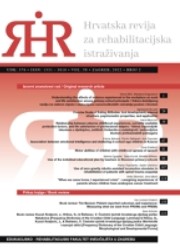ODNOS NEPOVOLJNIH ISKUSTAVA U DJETINJSTVU, ZAŠTITNIH ČIMBENIKA U SADAŠNJOSTI I ZADOVOLJSTVA ŽIVOTOM PROFESIONALNIH POMAGAČA
RELATIONSHIP BETWEEN ADVERSE CHILDHOOD EXPERIENCES, CURRENTLY AVAILABLE PROTECTIVE FACTORS, AND LIFE SATISFACTION OF PROFESSIONAL HELPERS
Author(s): Ivana MaurovićSubject(s): Personality Psychology, Psychology of Self, Behaviorism
Published by: Sveučilište u Zagrebu, Edukacijsko-rehabilitacijski fakultet
Keywords: adverse childhood experiences; life satisfaction; protective factors; professional helpers;
Summary/Abstract: Existing research on the well-being of professional helpers is mainly focused on the professional aspect. There is very little data on their subjective wellbeing, as well as on the factors that contribute to it. So far, studies have shown that professional helpers have higher numbers of adverse childhood experiences (ACE), as well as higher levels of life satisfaction compared to the general population. This could indicate resilience, which is facilitated by internal and external protective factors. Our study aims to explore the contribution of ACE and internal and external protective factors in explaining life satisfaction among professional helpers, as well as to determine the moderating influence of internal and external protective factors on the relationship between ACE and life satisfaction. The research was conducted on a sample of 622 professional helpers, including pedagogues, psychologists, social pedagogues, and social workers. The results of the hierarchical regression analysis indicate that adverse childhood experiences, as well as internal (resiliency and general self-efficacy) and external protective factors (perceived social support from special person and family) significantly contribute to determining the life satisfaction of professional helpers. There are no significant interaction effects of protective factors and ACE, but together they contribute to explaining 1.5% variance of life satisfaction. At the same time, the introduction of interaction effects in the last step resulted in the loss of the predictive significance of ACE in explaining life satisfaction. These results indicate the long-term effects of ACE on life satisfaction, as well as the possible synergistic or cumulative effect of protective factors.
Journal: Hrvatska revija za rehabilitacijska istraživanja
- Issue Year: 58/2022
- Issue No: 2
- Page Range: 39-66
- Page Count: 28
- Language: English, Croatian

